Everything we know about the San Bernardino terror attack investigation so far
Here's the latest updates on the investigation into Syed Rizwan Farook and Tashfeen Malik, the shooters who attacked Farook's office holiday party, killing 14 and wounding 22, in what officials believe was an act of terrorism. They were killed in a shootout with police shortly after. Since the Dec. 2 attack, investigators have been piecing together evidence in an effort to pinpoint exactly what motivated the couple, and how their plan went undetected.
Latest in the investigation Farook's friend, Enrique Marquez Jr. was arrested Thursday and charged with conspiring to give material support to terrorists, according to federal documents that allege the two men had talked of attacking Riverside City College and a busy freeway during rush hour. READ MORE
Enrique Marquez, the neighbor
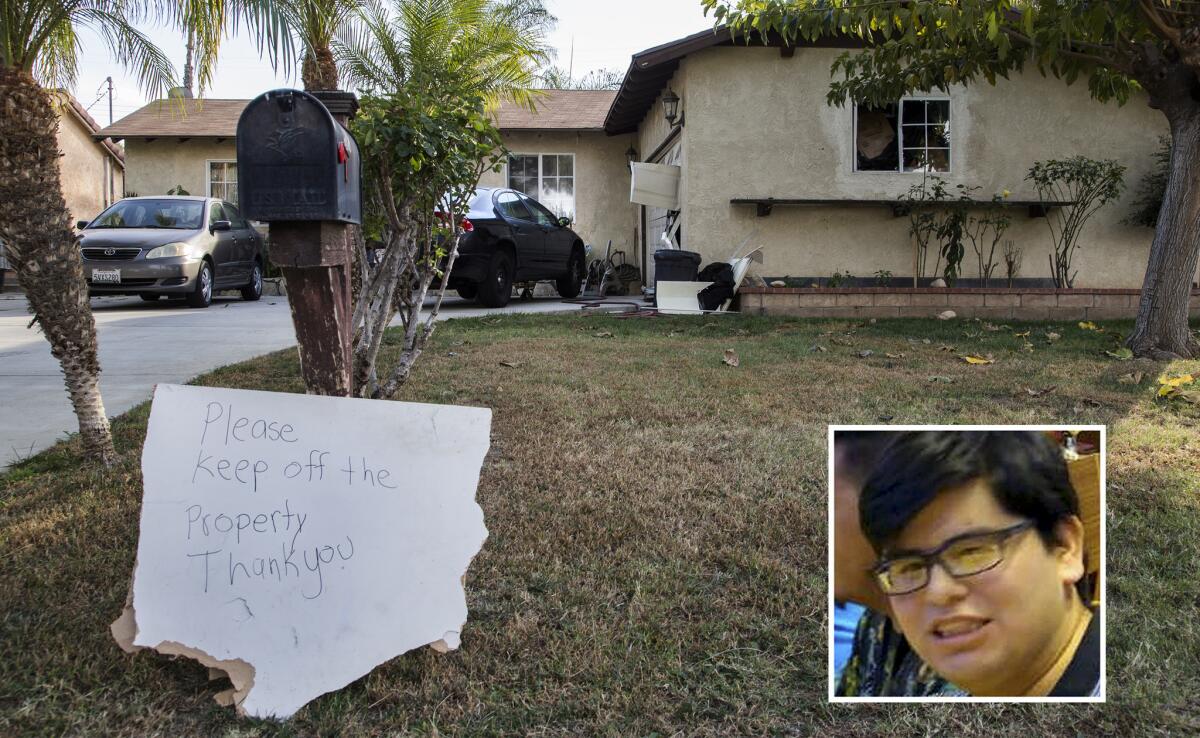
The Riverside home where Enrique Marquez reportedly lives with his parents.
Enrique Marquez Jr., a 24-year-old Riverside man who worked as a Wal-Mart security guard, is a central figure in the investigation.
He checked into a mental health facility on the day of the shooting and police searched his Riverside home -- next door to Farookâs old residence -- shortly after the shootings. He was said to be good friends with Farook and cemented his connection to his next-door neighbor by marrying the sister of Farook's sister-in-law in 2014. In 2011 or 2012, Marquez bought two of the rifles Farook and Malik used in the attack. A law enforcement source said he converted to Islam at some point, but when is unclear.
Marquez has waived his right to an attorney and been cooperative throughout marathon interviews with federal investigators, a law enforcement source said.
According to a law enforcement source, Marquez told investigators Farook wanted him to buy the guns because he feared he "wouldn't pass a background check" if he attempted to acquire the weapons on his own.
Marquez also told FBI agents Farook had made an earlier attack plan he didnât follow through on, according to a source.
An even bigger attack was planned
Two federal sources told The Times that before the shooting and their subsequent deaths, the couple was in the final planning stages for an assault on a separate building or location âwith a lot more people inside,â possibly at a nearby school or college. They based that assessment on data from digital equipment recovered from the coupleâs Redlands home, all of which was smashed in an attempt to hide their activities.
The weapons
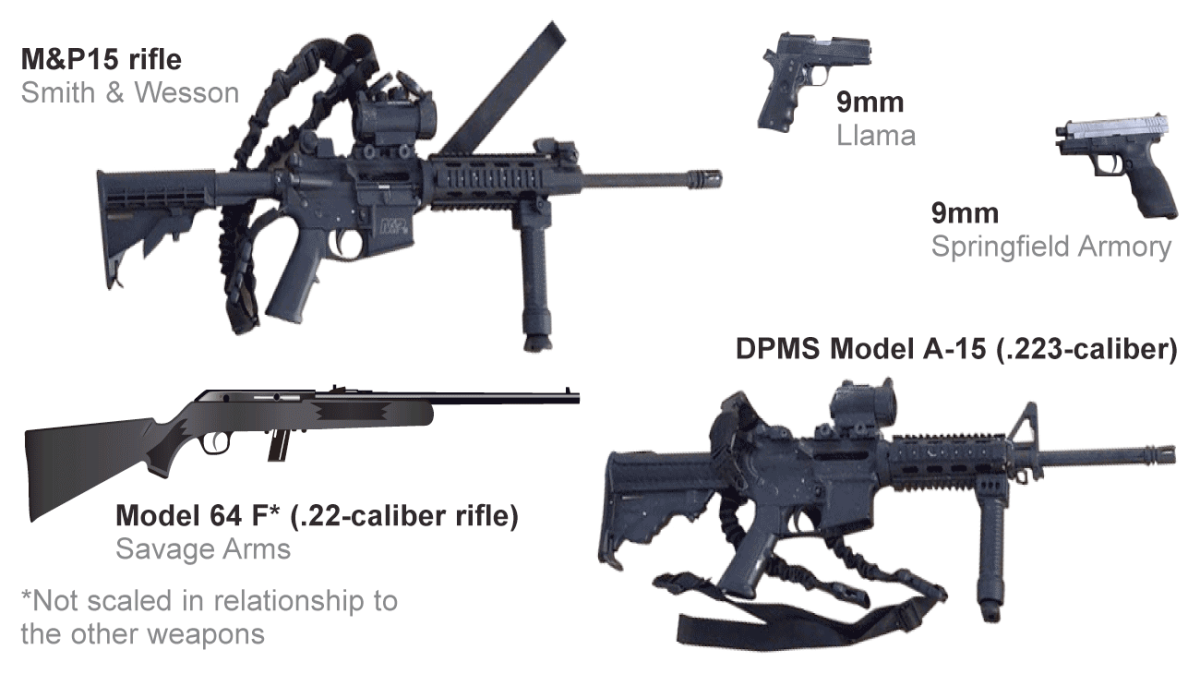
Farook and Malik used five firearms during the attack, and left behind three pipe bombs wired to a remote control. They did not detonate.
The shooters fire over 150 rounds during the initial attack and during a gun battle with police afterwards. They had more than 1,400 .223 caliber rounds and more than 200 9-millimeter rounds with them.
At their home, police found 2,000 9-millimeter rounds, more than 2,500 .223 rounds, several hundred .22 long rifle rounds and 19 pipes that could be converted into bombs.
Three of the guns were purchased legally by Farook between 2007 and 2012. He bought the handguns at Annieâs Get Your Gun in Corona. Two of the rifles were purchased by Farookâs friend and former neighbor, Enrique Marquez Jr., in 2011 or 2012.
What we know about the previous attack plan
Farook and possibly others may have planned a terrorist act as early as 2011 or 2012 but dropped it after four men were arrested â three of them in Chino â and ultimately convicted in a plot to kill Americans in Afghanistan , according to a government official.
The official said Farook may have told at least one associate in 2011 or 2012 that he was considering a terrorist plot. Itâs not clear who the associate was, but Farook friend Enrique Marquez Jr. told investigators about what Farook said, according to the official.
FBI agents believe Farook abandoned his plans to launch the earlier attack after a law enforcement task force arrested the three men in November 2012. The men were later convicted of charges related to providing material support to terrorists and plotting to kill Americans in Afghanistan. Investigators are looking into whether the men had ties to Farook.
The shooters' online communications
The investigation is in part focused on Malik and Farookâs digital lives, including how they communicated early in their relationship, and with terror groups.
The couple jointly pledged allegiance to Islamic State on social media shortly before they were killed in a shootout with police, the FBI has said.
Malik sent at least two private messages on Facebook to a small group of Pakistani friends in 2012 and 2014, pledging her support for Islamic jihad and saying she hoped to join the fight one day, two top federal law enforcement officials said. Messages of religious extremism on her Facebook account in late 2014 were a source of concern for her family in Pakistan, a family member in Pakistan told The Times.
Farook used several dating and matrimonial websites, including BestMuslim.com, where he wrote he wanted âSomeone who takes her religion very seriously and is always trying to improve her religion and encouraging others to do the same using hikmah (wisdom) and not harshness."
FBI officials said that after the couple began dating online as early as 2013, they spoke to each other about jihad and martyrdom.Farook had some kind of digital contact with people from at least two terrorist organizations overseas, including the Al Qaeda-affiliated Nusra Front in Syria, a federal law enforcement official said.
The K-1 'fiancee' visa
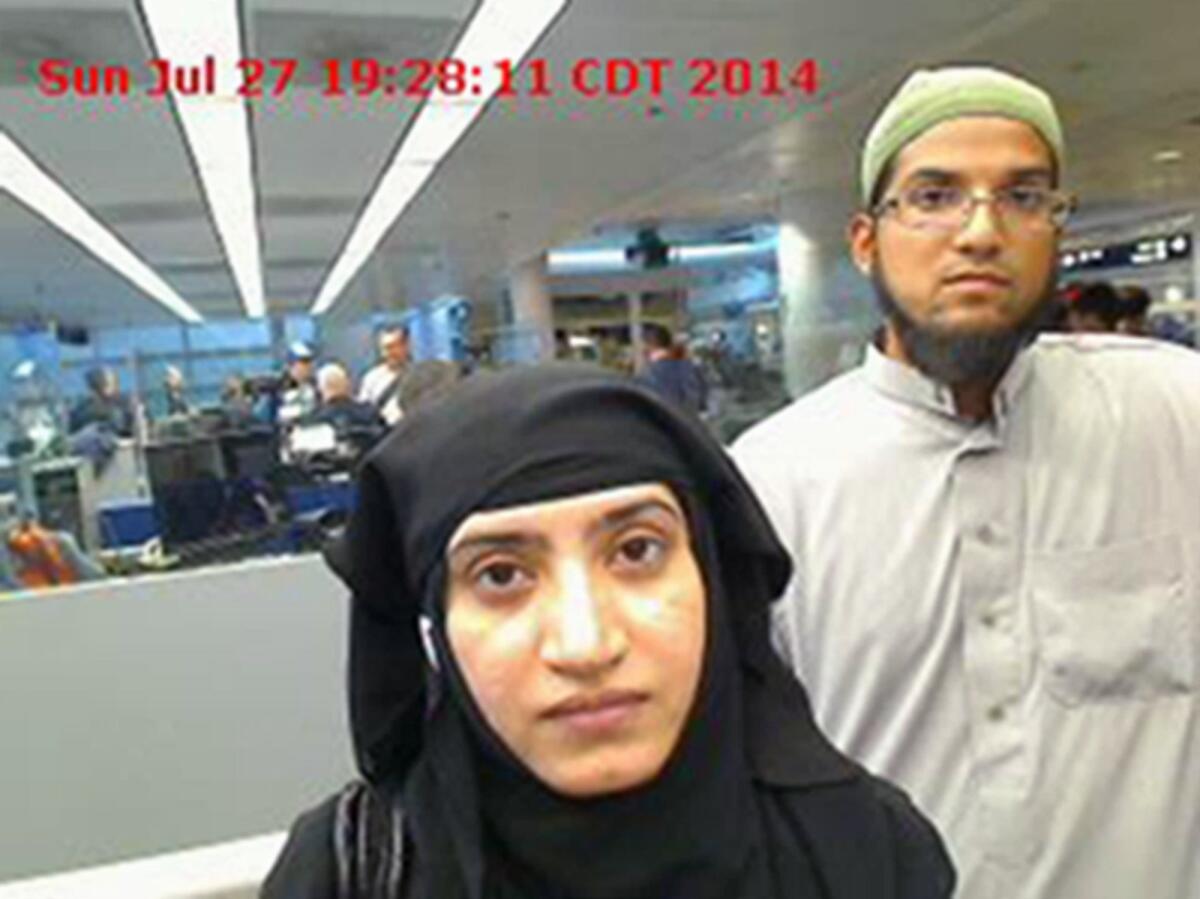
A photo from U.S. Customs and Border Protection shows Tashfeen Malik, left, and Syed Farook as they passed through OâHare International Airport in July 2014.
Investigators are looking into Malikâs K-1 âfianceeâ visa, which she had to be granted to enter the country with Farook.
Two government sources told The Times Malik used the name of a neighborhood or street near her home in Pakistan, rather than her family's home address, on her application. Investigators have speculated that she did so to deflect any investigation of her family's reputed ties to Islamic militants in Punjab.
K-1 applicants, like other visa applicants, undergo extensive counter-terrorism screening that includes checks based on fingerprints and facial recognition software. Questions for the partner seeking to come to the U.S. include: "Do you seek to engage in terrorist activities while in the United States or have you ever engaged in terrorist activities?" and "Have you ever or do you intend to provide financial assistance or other support to terrorists or terrorist organizations?"
The marriage
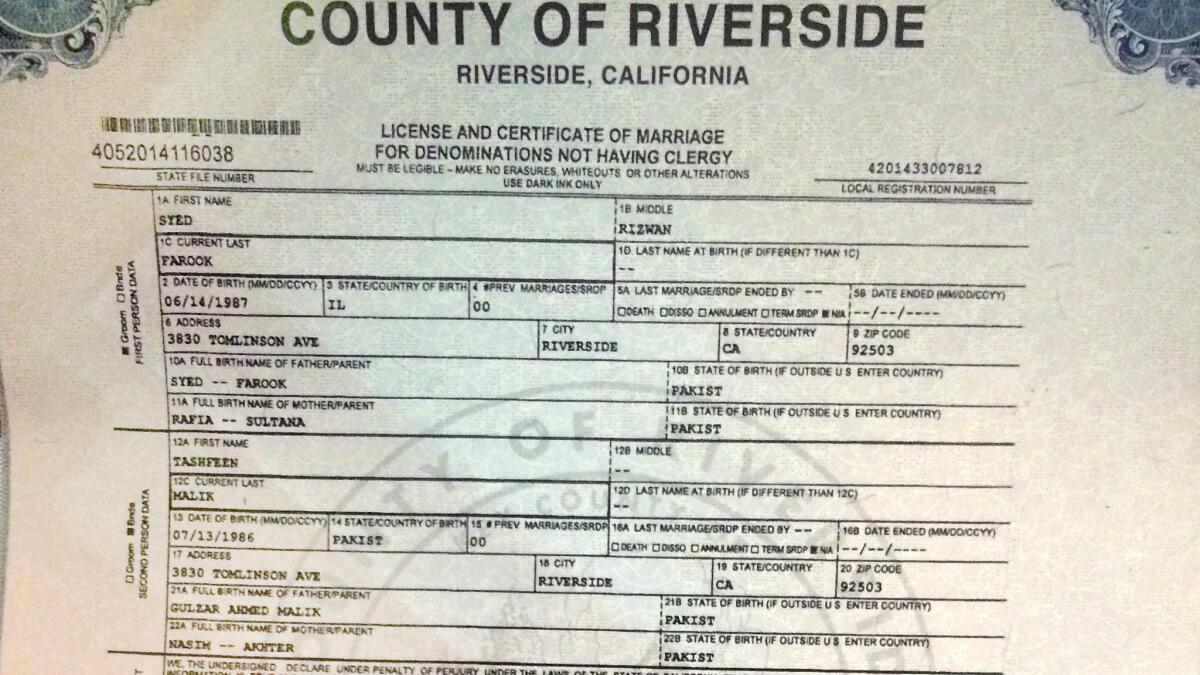
Copy photo of Syed Rizwan Farook and Tashfeen Malikâs marriage license from Riverside County.
The couple met online, and Farook traveled to Saudi Arabia in 2013 to meet Malik in person. The two married last year in Islam's holy city of Mecca in Saudi Arabia, according to Farook's co-workers. They then traveled to the U.S. together and got legally married in Riverside.
The circumstances of the marriage are now under investigation, an official told The Times.
Asked whether the marriage might have been purposely arranged by a foreign terrorist organization to sneak them into the United States to conduct an attack, the FBIâs director said he didnât know yet.
Where the investigation is happening
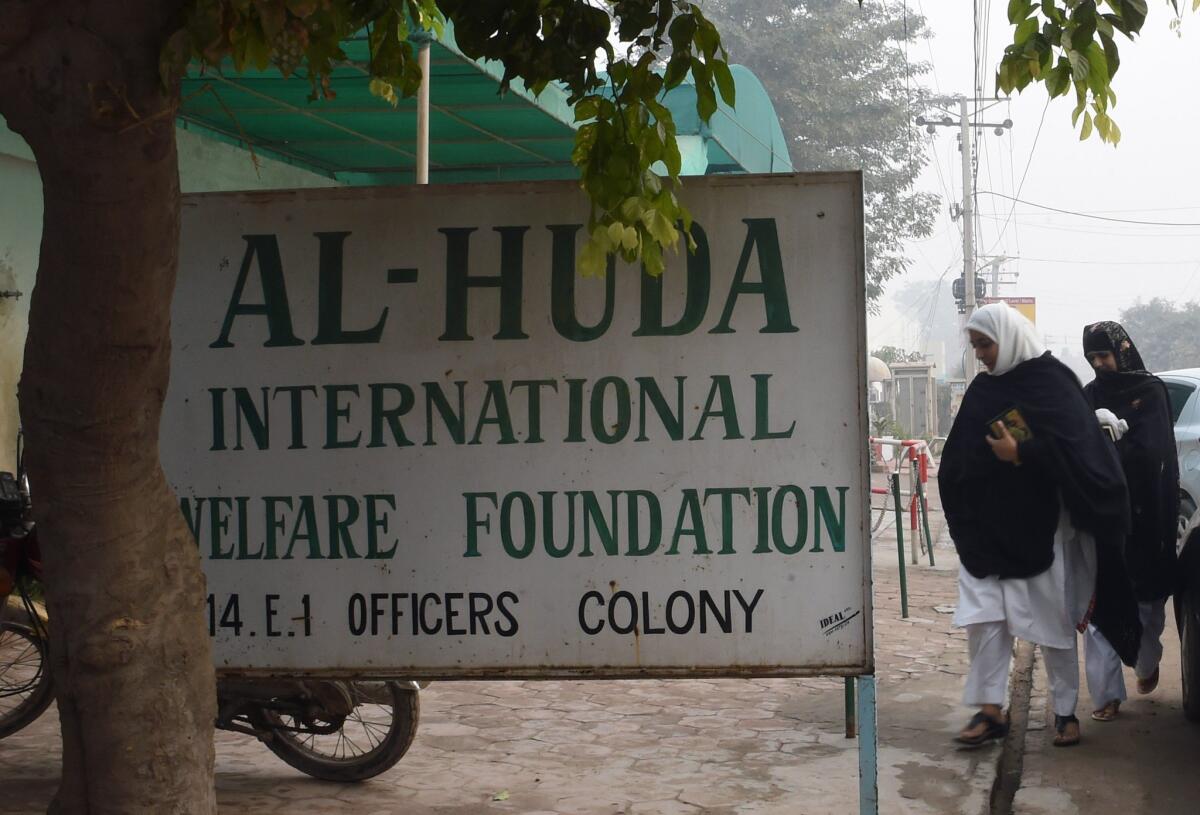
Pakistani students arrive at Al-Huda Institute, one of the most high-profile female seminaries (Islamic religious school), in Multan on December 8, 2015, where female US shooter Tashfeen Malik studied. The womenâs seminary in Pakistan where California shooter Tashfeen Malik studied for over a year disavowed the massacre, saying there is âno space for such acts in the name of Islamâ. Pakistani Malik, 29, pledged allegiance to the Islamic State group before she and her husband Syed Farook shot 14 people dead in California last week. AFP PHOTO / FAROOQ NAEEMFAROOQ NAEEM/AFP/Getty Images ** OUTS - ELSENT, FPG, CM - OUTS * NM, PH, VA if sourced by CT, LA or MoD **
Pakistan Where Tashfeen Malik was born, went to college and attended a womenâs Islamic seminary. Members of Malik's extended family live in Pakistan.
Saudi Arabia Where Tashfeen Malik spent much of her childhood, and where Malik met Farook in person for the first time in 2013. The two met again in 2014, where they were married in Islam's holy city of Mecca in Saudi Arabia, before Farook brought Malik to the United States. Members of Malik's immediate family live in Saudi Arabia.
Riverside Where Farook grew up and went to high school, and where he became friends with his next-door neighbor , Enrique Marquez Jr., who purchased the two military-style rifles used in the massacre. Farook and Marquez were neighbors until a few months ago. Farook practiced shooting with an AR-15 at the Riverside Magnum Range and attended a mosque there.
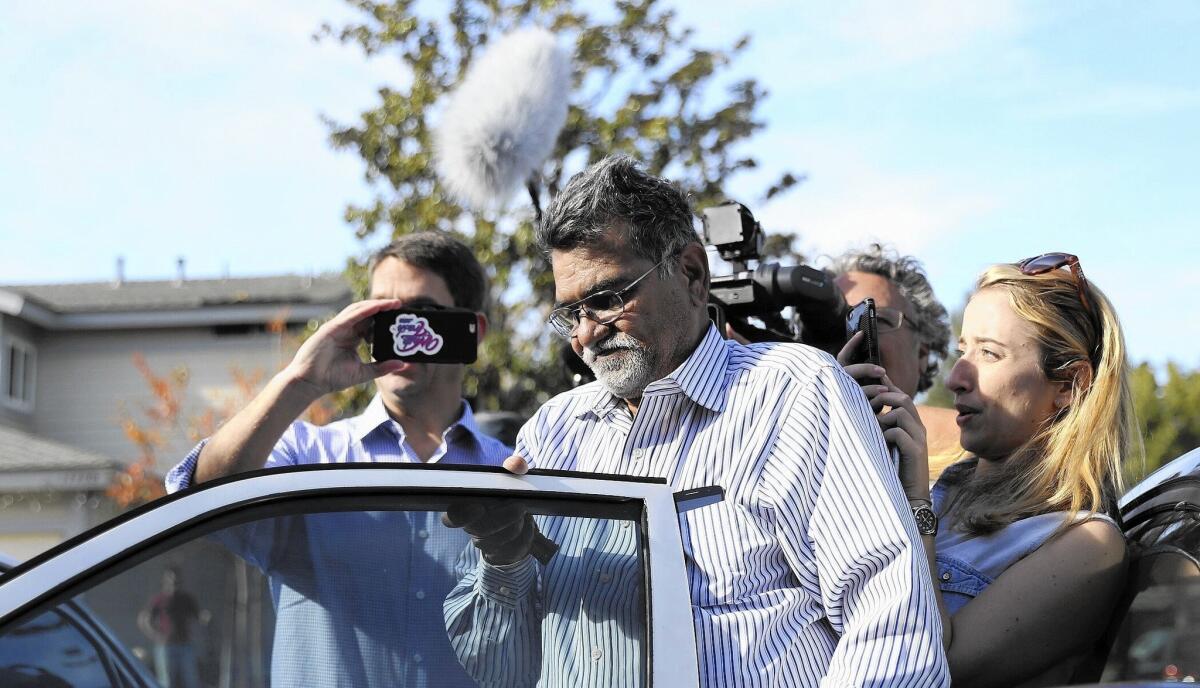
Syed Farook, father of one of the San Bernardino shooters, arrives home to a media swarm in Corona, Calif.
Corona Where Farookâs brother, Syed Raheel Farook, has lived with his wife, Tatiana A. Farook, since February. Farook's father also lives there.
Redlands Where Farook and Malik moved in May, the month their daughter was born.
San Bernardino Where Farook and Malik began their shooting rampage and where the final shootout occurred between them and police. Also the location of Seccombe Lake, where FBI divers searched for electronics that may have been dumped by the shooters and removed several items. Farook also attended a mosque in the city shortly before the massacre.
How they funded their attack
Farook worked for the county as a health inspector, and many of the details of the coupleâs finances are not yet known. But in the weeks before the San Bernardino massacre, the husband-and-wife assailants got a $28,500 loan, which authorities believe may have helped them acquire last-minute firearms, ammunition and components to build explosives.
The couple received the loan from San Francisco online lender Prosper Marketplace, according to Fortune and Bloomberg News.
Prosper is a leading player in the burgeoning world of online, peer-to-peer lending, acting as a middleman matching borrowers and investors who fund their loans.
Why their plot wasn't detected
Farook and Malik were unknown to law enforcement until the day of the shooting, but the reason for that isn't yet clear.
The FBI is focusing on how they missed the couple's secret radicalization and Farook's apparent comments to an associate as early as 2011 that he was considering a terrorist attack.
How they were radicalized

Pakistani students arrive at Al-Huda Institute, one of the most high-profile female seminaries (Islamic religious school), in Multan on December 8, 2015, where female US shooter Tashfeen Malik studied. The womenâs seminary in Pakistan where California shooter Tashfeen Malik studied for over a year disavowed the massacre, saying there is âno space for such acts in the name of Islamâ. Pakistani Malik, 29, pledged allegiance to the Islamic State group before she and her husband Syed Farook shot 14 people dead in California last week. AFP PHOTO / FAROOQ NAEEMFAROOQ NAEEM/AFP/Getty Images ** OUTS - ELSENT, FPG, CM - OUTS * NM, PH, VA if sourced by CT, LA or MoD **
Investigators believe the couple self-radicalized separately before meeting each other. Possible sources of radicalization investigators are looking into include:
Malik
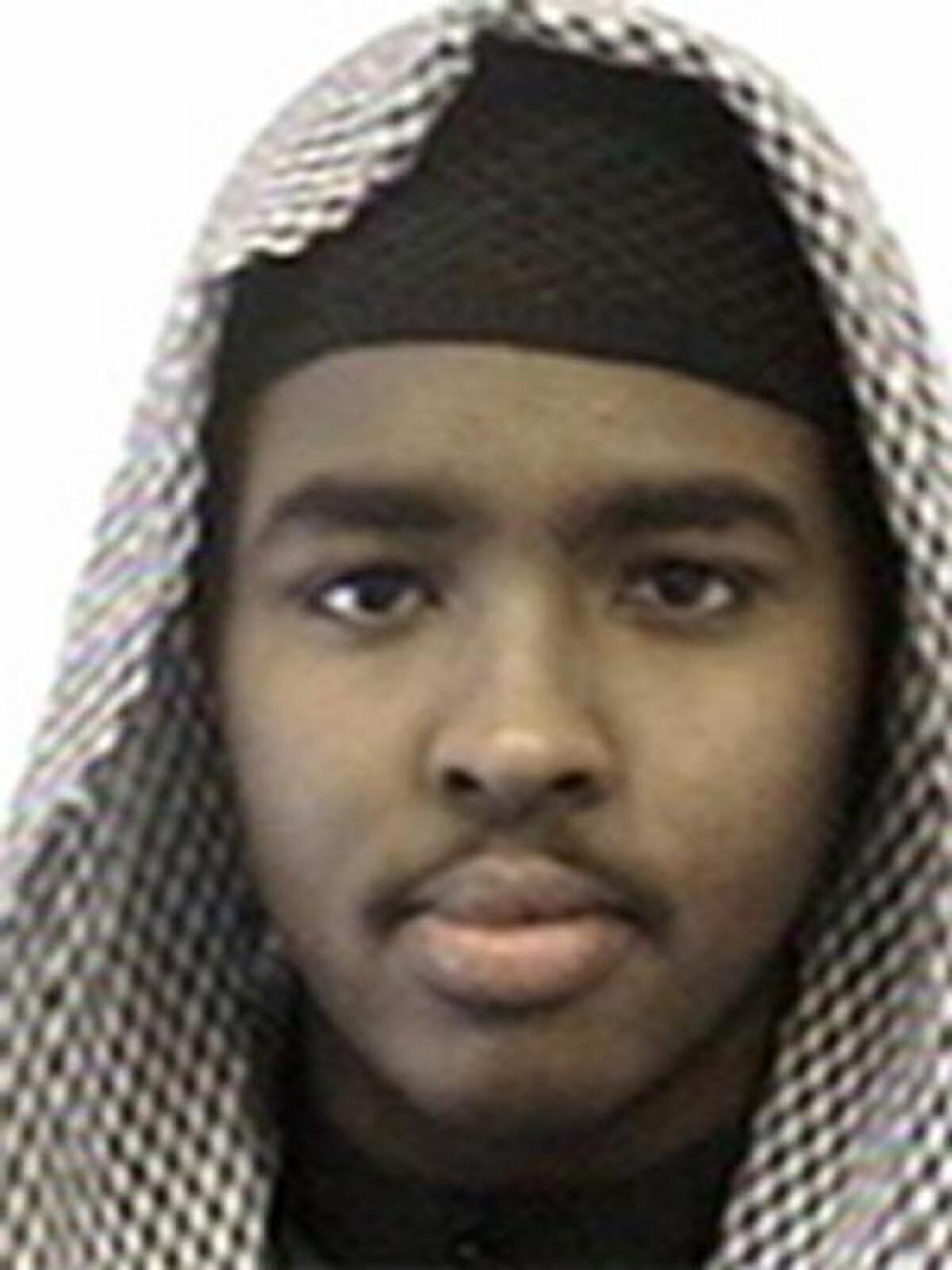
This undated photo provided by the FBI shows Mohamed Abdullahi Hassan, who turned himself in to authorities in Africa, the U.S. State Department said Monday, Dec. 7, 2015. A former Minnesota resident, Hassan joined al-Shabab in Somalia more than seven years ago and more recently went online to urge others to carry out violence on behalf of the Islamic State group, authorities said. (FBI via AP)
Farook
Sign up for Essential California
The most important California stories and recommendations in your inbox every morning.
You may occasionally receive promotional content from the Los Angeles Times.







